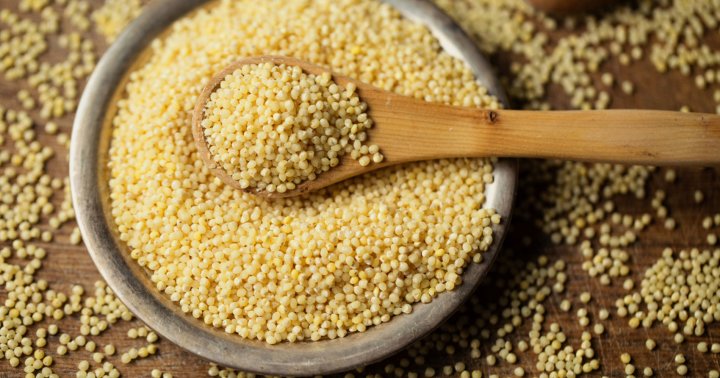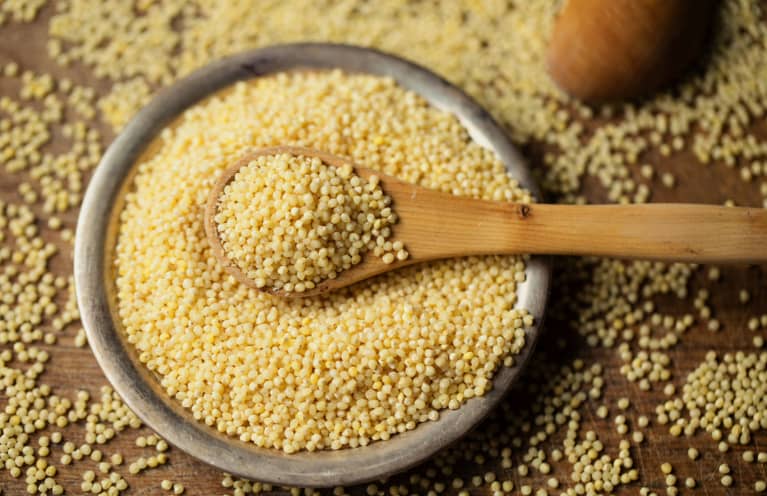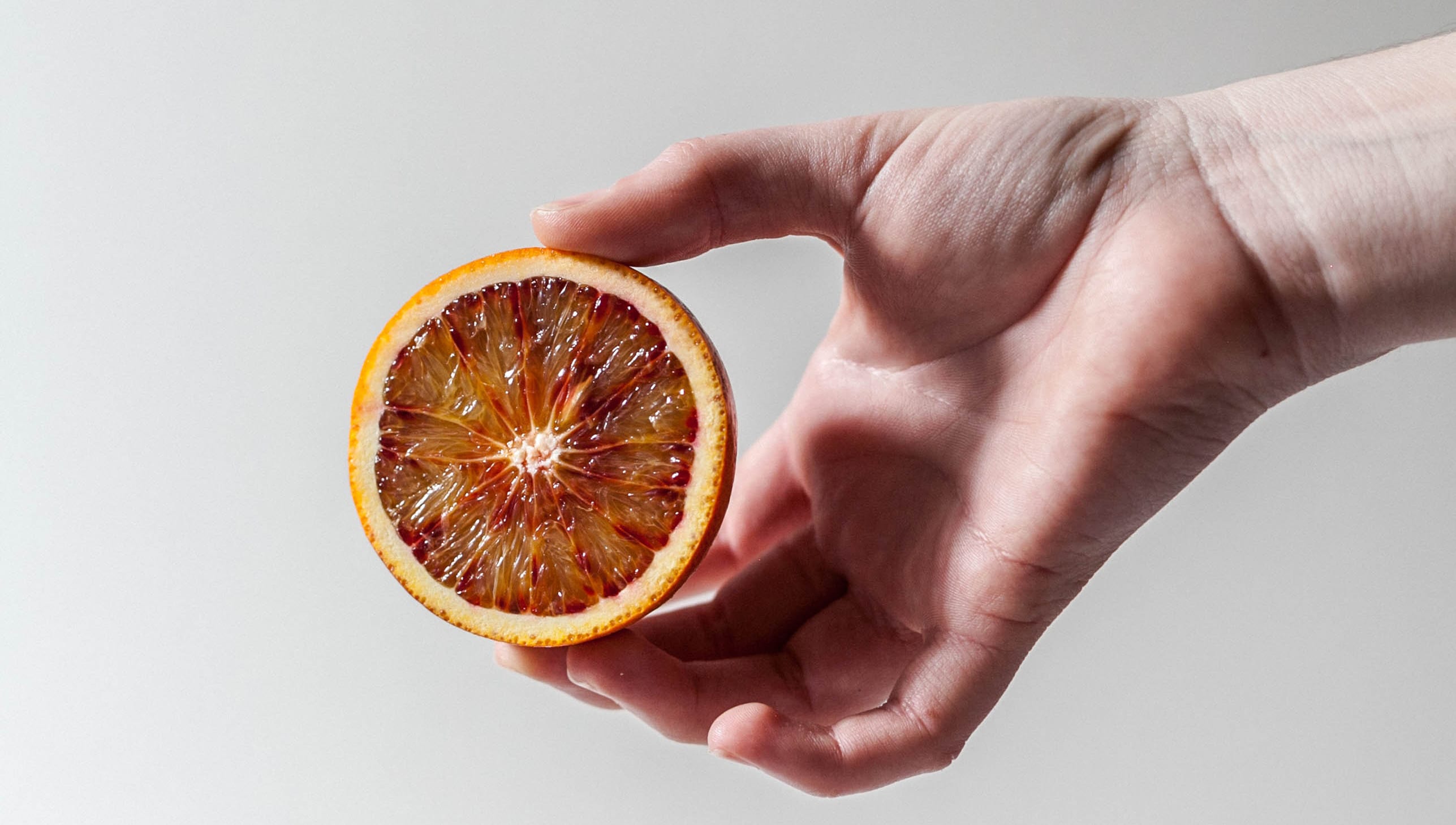This Underrated Whole Grain Is Packed With Iron & Supports Healthy Blood Sugar
Plus, how to cook with it.


February 12, 2022 — 11:31 AM
Millet is an ancient grain that absolutely deserves a spot in our modern diets. While it's often overshadowed by more popular grains like quinoa, oatmeal, or barley, this corn-like seed grain is packed with nutrition (we're talking awesome amounts of fiber).
While millet is technically a seed, its properties are most similar to a whole grain. If you find yourself getting tired of eating brown rice and oatmeal every day, you may want to add this ancient grain into your diet for some variety. Keep reading to learn why millet is a great addition to your diet.
Millet is a type of cereal grass in the Poaceae family, according to registered dietitian Sarah Jackson, M.S., RDN, CLT of Origin Nutrition. And while this grain is commonly found in bird food, it’s also a nutritious grain for the human diet. In fact, there are various countries around the globe that consider millet a diet staple.
Functional Nutrition Training
A cutting-edge nutrition deep dive taught by the world’s foremost health & wellness experts.

“Most of the millet found in grocery stores today is grown in India, China, and Niger, says nutritionist and mindbodygreen Functional Nutrition Training instructor Serena Poon C.N., CHC, CHN. It’s also grown in North and South Dakota, Colorado and Nebraska.
This naturally gluten-free grain looks similar to a corn kernel and is relatively mild in flavor with slight notes of sweet, corn-like flavor. As for texture, it has the fluffiness of couscous and a bit more dense than quinoa. Since it doesn’t alter the flavor of most recipes, millet is really versatile and is easy to incorporate in a variety of recipes. Not to mention, it’s one of the more affordable grains (more on that below), if you’re looking for wallet-friendly options to add to your meal plan.
Nutritional benefits of millet
Like other whole grains, millet is chock-full of nutritional benefits. One cup of cooked millet clocks in at 6 grams of protein and 2 grams of fiber. It’s also a good source of folate, B vitamins and minerals like magnesium, phosphorus, calcium and iron, Jackson says. The combination of fiber and protein supports a healthy digestion since the insoluble fiber content acts as a prebiotic, “which feeds the good bacteria in the gut microbiome,” Jackson says.
In a recent review published in Frontiers in Nutrition, researchers detected a link between eating millets and higher levels of hemoglobin, the iron-rich protein that carries oxygen throughout the body. They found that regularly eating millets may reduce iron deficiency anemia, which is responsible for 50% of anemia cases worldwide.
Compared to other grains, millet is also a relatively low-glycemic food, and past research has even noted it could be a helpful food for supporting healthy blood sugar levels.
It has environmental benefits, too. Millet is known to have a low carbon footprint because it doesn't need much water, and grows well at high temperatures.
“The major difference between quinoa and millet is the amino acid profiles and pH levels,” Jackson says. “All nine essential acids are found in quinoa, making it a complete protein, while millet would need to be paired with another grain or seed such as chia or flax seed to be a complete protein.” As for the pH of these grains, Jackson says quinoa is acidic, while millet is alkaline. So if you have a sensitive tummy, reach for millet over quinoa since it’s easier to digest.
Although different in some ways, millet and quinoa have quite a few similarities, too. They’re both naturally gluten-free and are considered a whole grain. And since both quinoa and millet have prebiotic properties, they’re great for supporting good gut health.
Now that we know why millet is a great addition to a healthy diet, let’s discuss how to use it. Truth be told, there aren’t many limitations to using millet. This grain has the same versatility as quinoa or rice, and it's a great healthy carb or grain option to round out any meal.
While millet flour doesn’t work as a substitution for all-purpose flour, it can be a great addition to recipes for boosting fiber and protein content. Jackson says you can grind up millet for a nutritious, gluten-free flour to make your favorite breads and baked goods.
If you want to prepare millet on it’s own, boiling is the best method. “The common ratio of liquid to millet is 2:1 cups,” Jackson suggests. “When hydrated and cooked, millet can triple in size and take on a soft fluffy texture.” Once it's cooked, you can add it your favorite salads (like this Beet, Apple and Raspberry Salad with Herb Millet), soups, chilis, or even use it as a side dish to your favorite meal (such as this easy Vegan Millet Pilaf). There’s also these Protein-Packed Millet Burgers that are perfect to toss on grill or whip up in a skillet for your next #MeatlessMonday dinner.
Millet is a great staple to practically any diet. It’s rich in protein, fiber, and is suitable for gluten-free and diabetic diets. Plus, it’s super versatile and makes for a perfect addition to breakfast, lunch, or dinner.
https://www.mindbodygreen.com/articles/millet

 Troov
Troov 

























.jpg&h=630&w=1200&q=100&v=f776164e2b&c=1)






